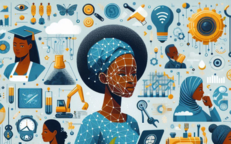The Use Of 3D Technology In Preserving African Cultural Artefacts
This is the 6th post in a blog series to be published in 2024 by the APET Secretariat on behalf of the AU High-Level Panel on Emerging Technologies (APET)
Aspiration 5 of the African Union’s (AU) Agenda 2063 envisions a vibrant Africa with a strong cultural identity, shared values, and ethics. This includes fostering a cultural renaissance rooted in Pan-Africanism, revitalising African languages, and preserving the continent’s rich heritage. Emphasising the crucial role that cultural and creative industries, especially in job creation and economic empowerment for women and youth, initiatives such as the African Continental Free Trade Area (AfCFTA) and policy frameworks such as the Charter for African Cultural Renaissance and the Revised AU Plan of Action on Cultural and Creative Industries, and the Statute of the African Audio-Visual and Cinema Commission (AACC) guide the advancement of dynamics and development of culture and heritage across the African continent.[1]
Cultural heritage encompasses the traditions and practices developed by a community over time, and passed down through generations. It includes customs, places, objects, artistic expressions, and values that define a community’s identity.[2] Culture plays a significant role in shaping individual and collective behaviour influencing how people interact and develop within society. As such, culture provides a sense of belonging, particularly through shared a language, and reflects the essence of a community or nation.[3]
Culture holds significant importance for Africans various reasons. Firstly, Africans place great importance on culture as it provides individuals with a sense of identity and belonging to a community. It shapes their behaviours, attitudes, and beliefs, offering a framework for understanding one's place in the world. Secondly, the African culture like others, culture fosters unity and cooperation within communities. Shared conventions, traditions, and language create bonds among people, encouraging collaboration. Additionally, culture preserves the African society’s collective heritage through literature, music, art, and other forms of expression, ensuring a connection to the past and a sense of continuity. Embracing ethnic diversity in Africa enriches the societies by exposing individuals to different lifestyles and fostering creativity and innovation. Hence, safeguarding the African cultural heritage is essential for preserving our link to history and identity.
Cultural preservation in Africa involves conserving and protecting both physical and intangible aspects of cultural heritage to ensure their survival for future generations. This involves safeguarding African cultural artefacts, traditions, languages, and practices that hold significance using emerging technologies such as 3D printing. The African Union High-Level Panel on Emerging Technologies (APET) recognises 3D printing as an emerging technology with the potential to preserve the African cultural heritage in an era of rapid technological advancement. . The cutting-edge technology offers a precise and non-invasive method to replicate and restore historical African landmarks, buildings, and artefacts that are at risk of damage or have been lost over time. Also known as additive manufacturing, 3D printing creates three-dimensional items from digital files by depositing successive layers of material until the desired product is formed. Each layer represents a thinly sliced cross-section of the object, allowing for intricate replication and restoration.[4]
APET notes that 3D printing is transforming the approach to preserving Africa’s cultural heritage, offering solutions for safeguarding delicate artefacts, restoring damaged structures, and increasing accessibility to cultural treasures. For example, the Iziko Museums of Cape Town in South Africa have successfully employed 3D printing to replicate ancient San rock art, protecting the originals from potential damage. Moreover, 3D printing facilitates restoration efforts by creating replacement pieces that match damaged artefacts or architectural features. Researchers in Egypt are exploring 3D printing to restore damaged hieroglyphs on ancient temples, preserving historical narratives. Even in cases where original materials or construction techniques are unavailable, such as at Great Zimbabwe, 3D-printed bricks have proven effective.
Additionally, 3D printing democratises access to cultural heritage by enabling museums to produce replicas for travelling exhibits, bringing treasures to remote communities. Educational institutions use 3D-printed artefacts to create interactive learning experiences, fostering deeper connections with cultural heritage. 3D scanning captures digital blueprints, creating high-fidelity models archived online for global accessibility, facilitating international collaboration and knowledge sharing. The Zamani Project leads the way in using 3D technology to meticulously recreate Africa's cultural landmarks digitally, preserving over 60 locations across 16 AU Member States and over 200 monuments. Their efforts ensure the preservation of Africa’s cultural heritage for future generations, promoting cultural awareness and education on a global scale. As physical structures deteriorate, these digital legacies will endure as testaments to Africa’s vibrant past.
APET suggests that national 3D cultural preservation programmes can establish dedicated initiatives for the scanning and documentation of cultural heritage sites, fostering collaboration between government agencies, universities, and private companies. These programmes can also focus on skills development and training, equipping local communities with proficiency in 3D technology, including laser scanning and data processing, thereby creating job opportunities and empowering communities to preserve their heritage. Moreover, open-access data-sharing policies are encouraged to facilitate the use of 3D data for educational purposes and innovative product development by researchers, educators, and entrepreneurs.
APET also proposes that integrating 3D technology into cultural heritage tourism can enhance tourist attractions and generate revenue for local communities, while clear intellectual property frameworks ensure communities benefit economically from their heritage. Additionally, investments in 3D printing infrastructure within AU Member States can facilitate technology adoption and innovation, while schools and universities are equipped with 3D printers and resources for interactive learning experiences. Therefore, support for developing 3D printing applications within creative industries and local craft sectors can significantly promote cultural preservation and economic growth. Most importantly, exploring 3D printing for restoration projects ensures the preservation of historical structures for future generations.
In conclusion, APET posits that the intersection of technology and cultural heritage protection represents a promising and transformative trend. The advent of 3D printing offers unprecedented opportunities to preserve our historical treasures, facilitating their accessibility and ensuring their survival for generations to come. By harnessing the capabilities of 3D printing, Africa can not only protect its cultural heritage but also improve its capacity to share and learn from its culture. As Africa further develops and advances 3D technology, the potential for cultural preservation expands, creating a digital link to the continent’s past and deepening our understanding of history. Through ongoing innovation and collaboration, African countries can fully utilise 3D technology to preserve and celebrate the diverse cultural legacies of on the continent and beyond.
Featured Bloggers – APET Secretariat
Aggrey Ambali
Justina Dugbazah - The Sahara Institute
Barbara Glover
Bhekani Mbuli – University of Johannesburg
Chifundo Kungade
Nhlawulo Shikwambane
[1] https://au.int/sites/default/files/documents/40121-doc-e-_draft_concept_note_on_2021_as_the_year_of_arts_culture_and_heritage_in_africa_.pdf
[2] https://www.heritageforpeace.org/heritage-for-peace/what-is-cultural-heritage/
[3] https://www.blackpoolgrand.co.uk/why-is-culture-so-important-to-our-lives
[4] https://3dprinting.com/what-is-3d-printing/


